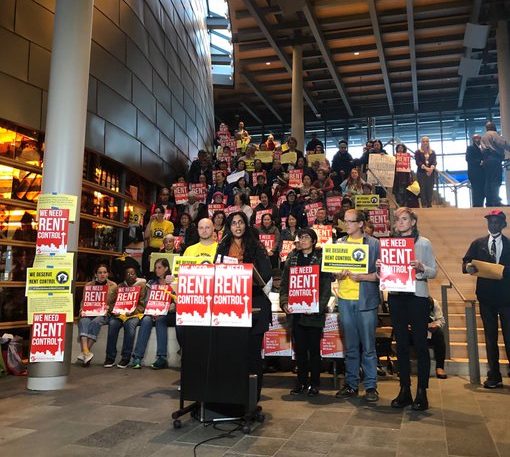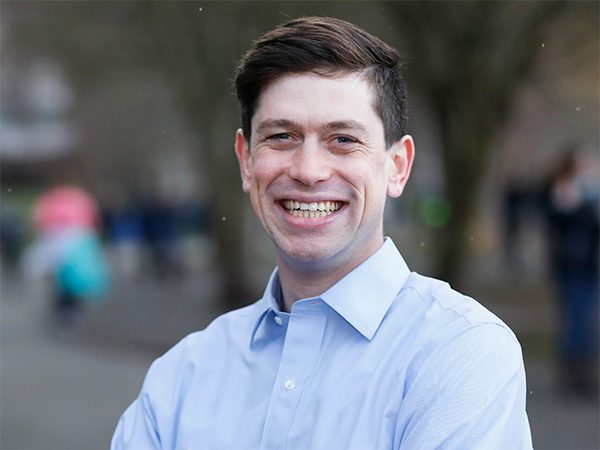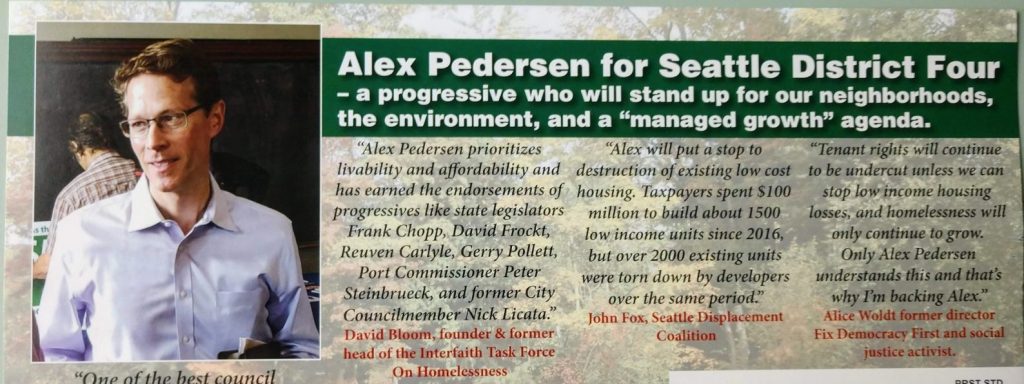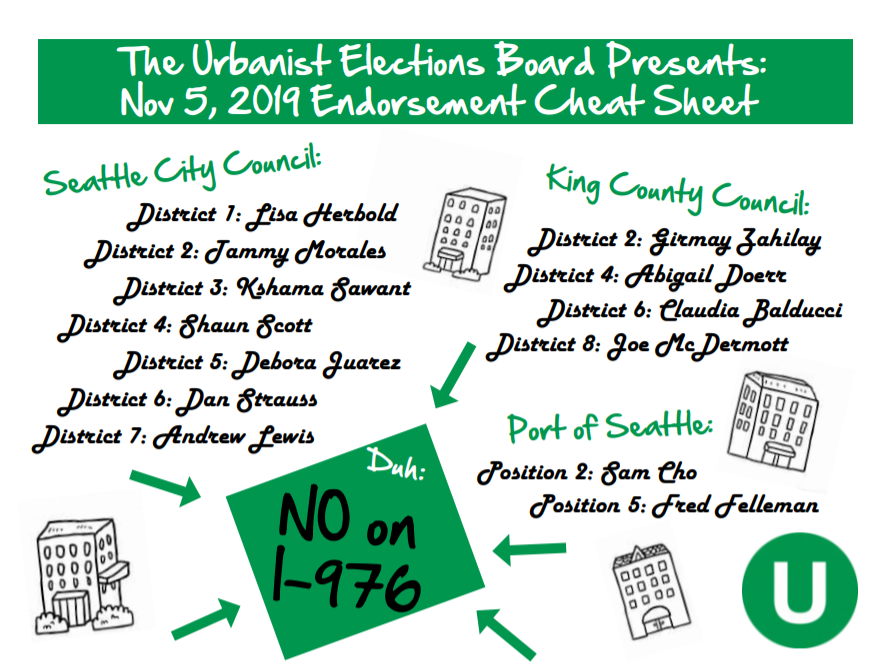
We live in alternate realities. I realized this when I received a pro-Alex Pedersen mailer from People for Affordable Livable Seattle (PALS) political action committee (PAC) arguing that recent development had cost more low-income housing than it replaced. Longtime housing rabble-rouser John Fox of the Seattle Displacement Coalition endorsed Pedersen, co-founded PALS PAC to run ads for him, and included the following quote in the mailer.
“Alex will put a stop to the destruction of existing low-income housing,” Fox said. “Taxpayers spent $100 million to build about 1,500 low-income units since 2016, but over 2,000 existing units were torn down by developers over that same period.”
Were the majority of those demolished homes low-income ones renting below market? I contacted the group to substantiate their claim, and, despite some efforts, they could not.
“Our campaign’s entire platform centers around protecting the most vulnerable and ensuring that everyone has the right to live in the city,” Shaun Scott said in an email. “We can soundly predict that our campaign’s policy proposals will do more to ensure Seattle’s livability than our opponent, who applied for the Chamber’s PAC money and worked for a housing developer that applauded Trump. Voters can rest assured that we won’t give in to fear-mongering but will materially improve their lives. That includes creating a land bank, building public housing, fighting for their rights, and working with state electeds to reverse our regressive tax system.”
PALS, by the way, is the political arm of slow-growth homeowner groupies that sued the City to block the Mandatory Housing Affordability (MHA) program. Unsuccessfully. MHA is the law of the land–at least multifamily-zoned land–and they appear pretty bitter about it. Single-family zoning still consumes about 75% of Seattle’s residential land and comes with no affordability requirement whatsoever.
Alex Pedersen opposed the MHA program at the time, as you can see in an archive of his deleted 4toExplore blog. When Pedersen first announced his candidacy, it was largely PALS and other homeowner activists that were listed in the endorsements. They are his firmest base.
Now Pedersen is making more wishywashy statements, but still arguing for reintroducing parking requirements, rolling back some rezones, and limiting growth to fixed transit corridors. Plus he is ducking debates where he could illuminate his positions, like the housing debate we co-hosted with the American Institute of Architects—Seattle Chapter (AIA Seattle). His opponent Shaun Scott was there, as was Dan Strauss (D6), Andrew Lewis (D7), Councilmember Kshama Sawant (D3), and Councilmember Debora Juarez (D5)–strong proponents of MHA upzoning. (Jim Pugel was also there, but a bit more skeptical of upzoning.)
Incidentally, their housing and land use policies were much better than their more conservative opponents. They weren’t trying to hide; they wanted to lead on housing and all agreed that rolling back apartment bans was an important step, as was increasing funding for supportive housing and social housing.
Seattle’s spate of development–which is overwhelmingly (at least 85%) in Seattle’s urban villages and centers and that consume a sliver of the land overall, I might add–allowed Seattle’s population to jump from about 685,000 in 2015 to something like 750,000 today–a jump of roughly 65,000 in four short years. Seattle is averaging about 10,000 new apartments per year in the last five years. Let that sink in: 50,000 homes that didn’t exist five years ago today exist. Meanwhile, many single-family zoned neighborhoods are actually shrinking in population as the urban villages boom around them.
Nonetheless, John Fox of the Seattle Displacement Coalition is very worried about demolition of some existing homes. Two thousand units have been demolished since 2016, he said, and he’s cocksure that the majority of those are naturally occurring affordable homes. Why does he think that? Well, he cites unscientific surveys his organization conducted “on three occasions over the last 20 years,” but then didn’t publish in detail. Sounds legit, right? Let’s interrogate that.
But first let’s talk about some good housing policies, before dwelling on the bad.
Scott: Public Housing Is Priority #1

While Alex Pedersen is a very bad and conservative candidate that wants to go backwards on housing, the progressive slate is excellent on housing. We should be excited about that. The first thing on Shaun Scott’s platform is public housing and from day one he has been adamant that single-family zoning is exclusionary, has racist roots, and must go. He’s also listed a handful of revenue sources–from another head tax to vacancy taxes to congestion pricing–and made it clear he’ll go to the mat against wealthy corporations, landowners, and car activists to get them.
Sawant: Tax the Rich, Stabilize Rents, Build Social Housing
Councilmember Kshama Sawant has been an enthusiastic vote for more revenue to build social housing, and it’s still a centerpiece of her platform. If anybody is going to bring back the head tax, it’s Sawant who voted against repealing it in the first place. Despite whisper campaigns, Sawant has voted for just about every single upzone this city has considered. She also increased the MHA upzones in some parts of her district. Does she ruffle feathers? Yes, she does. Does zoning reform ruffle feathers? Yes, it does. So maybe the socialist who ruffles feathers is actually well-suited for this tough fight to democratize our land use.

Councilmember Sawant is leading on homelessness and the need for an urgent compassionate response to address our immediate problem. She introduced draft legislation to expand tiny house villages, adding up to 40 sites. Each tiny house village has had between 16 and 48 tiny homes, so that means Sawant’s proposal could make good on an unfulfilled campaign promise from Mayor Jenny Durkan to add 1,000 tiny homes in her first year. Mayor Durkan added 73 tiny homes–927 short of her pledge.
Sawant is also pushing hard for rent control, which is important given the incredible housing insecurity and economic displacement happening in this city. Does her rent control proposal go too far? Perhaps, but can you imagine rent control and tenant exploitation even being in the conversation without Sawant? Her Overton window strategy may upset some–like State Senator Jamie Pedersen (D-Seattle) who seems willing to kill the policy to spite her–but if the outcome is getting a second-generation rent control proposal that lowers displacement, it will surely be a good outcome.
Sawant’s opponent, Egan Orion, skipped our housing debate. Despite running a fairly pro-growth (and even backed rent stabilization) primary campaign, he’s waffled or ducked tough housing stances lately. His base of support is in the wealthy single-family view homes in the idyllic corners of the district. Think Montlake, Broadmoor, Madison Valley, Madrona, North Capitol Hill, and so forth. These are the places a progressive candidate would end the pervasive apartment bans choking growth there and perhaps turn them into urban villages in their own right. Is Orion the kind of candidate to speak truth to his own base and get them to accept upzones once The Seattle Times op-eds start flying? I haven’t seen any indication of that.
Andrew Lewis: An Affordable Mass Timber Housing Champion

On the trail, Andrew Lewis fights an important battle. Duplexes and triplexes are beautiful he reminds voters and they fit right in with the district. Yes, even really Pleasantsville parts of Magnolia and Queen Anne. “BUILD MORE AFFORDABLE HOUSING” is Lewis’ first priority on his webpage. “Commit to building 5,000 units of affordable housing in three years by working with State, County, and non-profit partners through the ‘Home and Hope‘ plan.”
Lewis is also a big proponent of mass timber construction–an innovative building technique that replaces steel and concrete to lower a building carbon footprint and build beautiful housing. “Expand The Use of Cross Laminated Timber (CLT),” Lewis wrote on his priorities page. “14% of global carbon emissions are caused by the use of concrete and steel in construction. CLT would dramatically reduce this carbon footprint—in fact acting as a carbon sequestration resource. The use of CLT would additionally save the city money on construction projects ranging from community centers to affordable housing, and opening funding for other crucial public works projects.”
Dan Strauss: Missing Middle Man of the People

At the housing debate, Dan Strauss said he ran for city council because he was tired of seeing his friends priced out of Seattle. Strauss’s plan to fix that involves a lot of missing middle housing, such as duplexes, triplexes, and rowhouses. That means zoning changes.

Strauss has also been much stronger than his opponent on finding new progressive revenue to fund new affordable housing construction. Housing and homelessness services dominate Strauss’s issues page and it’s clear he sees the scale of the problem. He isn’t shying away from the challenge:
Ultimately, our homelessness crisis is about insufficient affordable housing. Seattle has 60,000 fewer affordable homes than we need for people making less than 50% of AMI ($38,750/yr), and we need to make a massive investment to create the housing stock we need. I will make full use of our bonding capacity, fast-tracking permit for affordable housing, waive city fees, and identify city property we can lease to housing providers.
Finally, Strauss has staked his campaign on the Housing First model, which emphasizes permanent supportive housing as a way to get homeless people back on their feet and work toward sobriety without threat of eviction. “We need to invest in [permanent supportive housing] fully and start building it at four times the current rate,” Strauss wrote. Supportive housing first is the model experts like Dr. Sara Rankin have advanced due the strong data supporting both its efficacy and cost-effectiveness. People stabilized in housing cost taxpayers less than people experiencing addition or mental health issues on the street. A lot of candidates (e.g., Milquetoast Moderates) pay lip service to Housing First, but as soon as there’s a visible problem, they’re back to wack-a-mole and tough love with people experiencing homelessness to score easy points. Strauss, on the other hand, is making a firm commitment.
Interrogating John Fox’s slanted math
Now back to our PALS. As it turns out, much like John Fox’s imaginary math during the debate around the University District rezone–which The Seattle Times uncritically trumpeted and we exposed at the time–Fox’s displacement math is still the product of guesswork and fantasy. The 2,000 units worth of demolitions he could substantiate with a City report. However, he also claimed most of these demolitions were naturally-occurring affordable homes (NOAHs)–market-rate, low-income units in other words.
Side note: if Fox knows where landlords are voluntarily renting for less than $1,000, he should spill the beans. Droves of working class renters would like to know!
Fox did point to a blog post he did on his site Outside City Hall that clarifies his assumption, although he wouldn’t divulge when these survey happened or exactly how these cutoffs for being deemed a low-income household were applied. That 70% of all demolished units in Seattle served low-income households stretch incredulity. We just don’t have that many NOAHs left, as anybody who’s actually looked for an apartment in the last few years can tell you. The median rental price in Seattle is $2,700, according to Zillow. Here’s what Fox wrote:
Our estimate that 70 percent of demolished units are occupied by low income households is based on past surveys we have done of residents occupying units in buildings where permits were pending for demolition and by using the reverse phone directory to call former residents of buildings torn down or already vacated for demolition. To downplay the impact of demolitions, city’s planners point to a much smaller number of low income households displaced from these buildings who qualified for and received relocation assistance under the Tenant Relocation Assistance Ordinance or TRAO. But most low income tenants in demolished buildings often aren’t even made aware of their eligibility under TRAO or for other reasons never apply for assistance, or the landlord forces them out before applying for permits so they never even receive notice of their eligibility. Also, TRAO limits eligibility for assistance to only households with a combined income below 50% of median.
The surveys Fox referenced are likely very similar to his MHA displacement risk surveys. Fox claimed more low-income units would be demolished than replaced due to the University District’s upzone. (This is an old canard for him.) But when we checked his figures, he was including buildings that were renting for well above the 50% of area median income cutoff he used–the 2019 rent limits are $968 for a studio, $1,038 for a one-bedroom, and $1,245 for a two-bedroom at 50% of area median income.

And after we highlighted Fox’s misleading claims in Janurary 2017, we pointed them out again in February 2018 when he popped up to oppose a Belltown demolition and again understated rents to bolster his claims. Yet, he keeps making these factually incorrect claims without really getting called out in the mainstream media. Here’s what we wrote in 2018:
John Fox’s infamous naturally occurring affordable housing (NOAH) surveys were heavy on apartments that A) weren’t actually that affordable and B) were relatively small studios. Ironically, many of these same folks oppose creating new small efficiency homes. By doing so, we’re creating a can’t-win situation. Mandating big home and lot sizes is a major reason why Seattle is on a Titanic-like course cleaving on an iceberg of massive inequality and displacement.
Given his past mistakes and lack of detail in his analysis, it seem likely that Fox has again significantly rounded down rents (or cited old figures) for demolished apartment buildings. Due to spiraling wealthy inequality and a tight housing market, rents have skyrocketed in this city. Rent surveys done 20 years ago are no longer very relevant. Apartments that were affordable for the first few decades of Fox’s 40-plus years of housing advocacy are no longer so–and to be clear: Fox has done great work in his long housing advocacy career; it’s too bad his more recent work has focused primarily on housing opposition.
The NOAH is going the way of the dodo in many Seattle neighborhoods, yet Fox thinks freezing neighborhoods in amber will save them. It won’t, especially without rent control. Note, Alex Pedersen opposes rent control, and Shaun Scott supports it. Malloy Apartments across from the Parrington Lawn at the University of Washington is now renting 450-square-foot studios for $1,600 or more. But still it was in Fox’s University District affordable housing survey.

Big picture what Fox is arguing is that adding 50,000 apartments in the last five years in rapidly growing Seattle is actually bad. With 2,000 demolitions to create about 50,000 new housing, that means those units were being replaced 25-fold. Fox and Pedersen still aren’t satisfied.
Now once you add MHA into the mix, 50,000 new apartments means at least 3,000 new low-income units averaging 6% affordability. MHA requirements range from 5% to 11%, depending on the intensity of the upzone and location. That means 2,000 demolitions to create 50,000 homes, at least 3,000 of them guaranteed affordable will surely replace more affordable units than it consumes.
The catch is that MHA wasn’t in place for most of that building boom. The “citywide” rezones passed in March 2019. Why was that? Here’s the irony and the kicker: it’s partially because John Fox and his PALS sued, delaying the MHA rezones at least a year with mostly flimsy process complaints. They have cost Seattleites affordable homes and now these demagogues are trolling us about it. It’s rich!
Even if you’re suspicious of for-profit developers, the MHA upzone importantly created additional suitable sites for affordable housing developers, easing the multifamily land crunch in our city, albeit not enough. Fox and Pedersen gloss over this fact. When it comes down to it, their biggest worry isn’t affordability, it’s homeowner complaints.
That’s why if you care about affordable housing, I urge you to vote for the progressive slate of candidates.

Doug Trumm is publisher of The Urbanist. An Urbanist writer since 2015, he dreams of pedestrian streets, bus lanes, and a mass-timber building spree to end our housing crisis. He graduated from the Evans School of Public Policy and Governance at the University of Washington in 2019. He lives in Seattle's Fremont neighborhood and loves to explore the city by foot and by bike.


